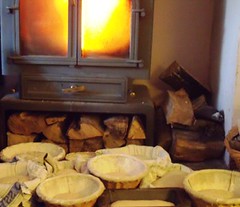 Light Pain au Levain; “Rossisky”using the Auerman Three Stage Process.
Light Pain au Levain; “Rossisky”using the Auerman Three Stage Process.
Yesterday I stoked up the wood-fired oven first thing, as I had around 8.5kg of dough retarded in my fridge, and a ripe Rye “Sponge”, ready to use to make a Pullman Pan loaf of high-rye bread.
I had to get up early on Sunday to start building the wheat leaven and rye sourdough, as I had minimal stock, as usual, and had decided I wanted to make a large batch of dough using the Hobart mixer, something a bit lighter as an alternative sample for the shop I had visited the day before.
I fed the wheat leaven 3 times over the day, starting with 40g of stock, and ending up with just over 2kg. I fed the rye sourdough twice in the same period, then made the “Sponge” last thing before going to bed.
Here are the formulae detail:
1. Light Pain au Levain
Material/Stage | Formula [% of flour] | Recipe [grams] |
1. Wheat Levain | | |
Carrs Special CC Flour | 25 | 1250 |
Water | 15 | 750 |
TOTAL | 40 | 2000 |
| | |
2. Final Dough | | |
Wheat Levain [from 1.] | 40 | 2000 |
Carrs Special CC Flour | 45 | 2250 |
Gilchesters’ Organic Pizza/Ciabatta Flour | 25 | 1250 |
Bacheldre Dark Rye coarse bran & meal | 5 | 250 |
Salt | 1.8 | 90 |
Water | 53 | 2650 |
TOTAL | 169.8 | 8490 |
| | |
% pre-fermented flour | 25 | - |
% overall hydration | 68 | - |
FACTOR | 50 | - |
Method:
- Build the leaven as described above and allow to ripen until just peaking.
- For the rye flour, sift Bacheldre flour several times, to separate the fine particles from the coarse. Reserve the fine flour for the Rossisky loaf, and use the coarse meal as part of the grist here.
- Weigh the water into the mixing bowl and add the ripened leaven. Lastly add the flours and salt. Attach a dough hook and mix for 15 minutes on first speed to develop the dough. Scrape down as necessaryduring mixing. Retard overnight.
- Leave the dough for 1½ hours to come back to room temperature, before scaling and dividing. I made 9 loaves from this dough. One in a pan, plus a variety of different-sized boules.
- Set to prove in the bannetons/pan, covered, for 3 – 4 hours whilst firing the oven.
- I had to bake these loaves in 2 batches, as the oven takes 5, maybe 6 loaves only, at one time.
- Cool on wires.











The first batch went into the oven whilst it was still a bit hot. Four of them were fine, and I sold them to my builder mates, so they are not pictured. The large and dark specimen is the one we are currently eating. Alison hasn’t had any yet, and I suspect it will be too well-fired for her taste; we shall see? However, the quality in the crumb is very pleasing indeed, a fine example of how baking hot directly on the sole can produce wonderfully gelatinised crumb. The crust has cracked beautifully and is pleasing in every aspect, except it is a little too dark! I took another loaf for a friend who helped me out recently with a supply of wood to fuel the fire. I gave 2 more away as samples to the shopkeeper I visited on Saturday. The other 2 go into the freezer.
The Samples:

2. “Rossisky”using the Auerman Three Stage Process.
I made the “Scald” at the same time as the final refreshment for the rye sourdough, then combined the “Scald” with the “Sour” to make the “Sponge” last thing at night. I made the final paste first thing in the morning.
Material/Stage | Formula [% of flour] | Recipe [grams] |
1a. Rye Sourdough | | |
Bacheldre Organic Dark Rye Flour | 30 | 300 |
Water | 50 | 500 |
TOTAL | 80 | 800 |
| | |
1b. “Scald” | | |
Bacheldre Organic Dark Rye Flour | 15 | 150 |
Red Malted Barley Powder | 5 | 50 |
Boiling Water | 35 | 350 |
TOTAL | 55 | 550 |
| | |
2. “Sponge” | | |
Rye Sourdough [from 1a.] | 80 | 800 |
“Scald” [from 1b.] | 55 | 550 |
TOTAL | 135 | 1350 |
| | |
3. Final Paste | | |
“Sponge” [from 2] | 135 | 1350 |
Bacheldre Organic Dark Rye –finely sifted | 30 | 300 |
Gilchesters’ Organic Pizza/Ciabatta Flour | 20 | 200 |
Salt | 1.5 | 15 |
TOTAL | 186.5 | 1865 |
| | |
% pre-fermented flour | 30 + 20 = 50 | - |
% overall hydration | 85 | - |
FACTOR | 10 | - |
Method:
- Build the sour as described, make the Scald, then combine the two to make the Sponge. Ferment this overnight.
- I sifted through the Bacheldre Organic Dark Rye flour, reserving the fine flour to use here, and using the coarse meal in the Pain au Levain. Add the remaining flour and the salt to the sponge in a mixer, and combine with the paddle beater to form a paste. Scrape the bowl down as required.
- Bulk proof for 1 hour.
- Line a Pullman Pan neatly with silicone paper and place the paste into the pan, neatening off carefully. Attach the lid.
- Final Proof 3 hours.
- Bake 2½ hours at 160°C in an electric oven with convection and a steady supply of steam.
- Cool on wires. Wrap in linen 24 hours before cutting.




For some reason my rye sourdough is not managing to raise this particular type of bread as effectively as in the past. The loaf did not quite hit the lid of the Pullman Pan, which I have usually achieved in the past. I kept the salt out of the Scald this time as I thought this may have been retarding activity in the Sponge. However, what I actually believe is the most likely problem is that the final paste appears a little tight. Rye flour is notoriously unpredictable when it comes to water absorption, however, past experience tells me to be wary of going much beyond that 85% hydration rate. I have worked with flour in the past which was so badly damaged by the milling that it was possible to just keep adding water and yet the paste never dropped at all. Of course, it then becomes impossible to bake the loaves as there is an excess of moisture which just cannot be driven off. I reckon I am going to have to be much more rigorous about temperature regimes throughout the entire process. Adding more water will be a last resort only.
I have just had a sample of this bread now, having cut off a portion to use as a sample in the shop in Wooler, and given a bit to the builders for their “elevenses”. The taste at least, is spot-on.
More baking later in the week; I will need to be getting more wood sorted as well!
Happy Baking!
Andy